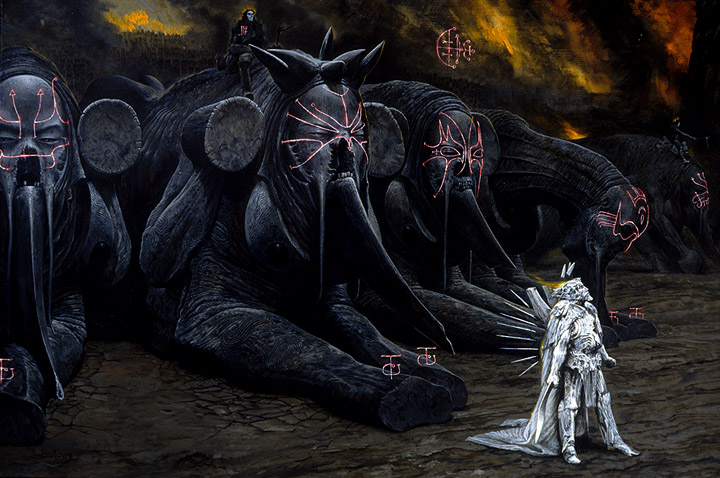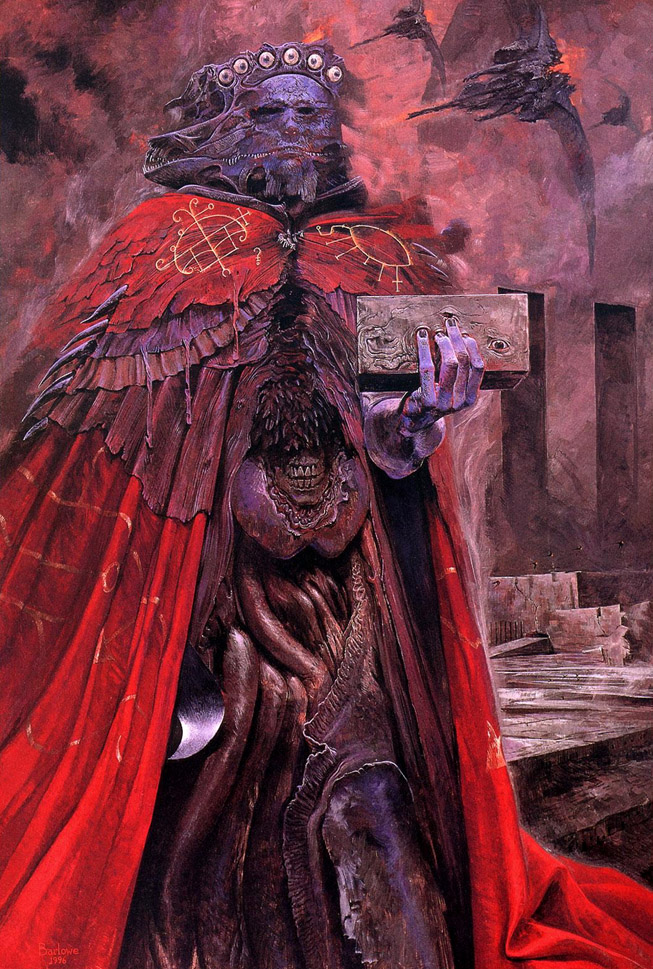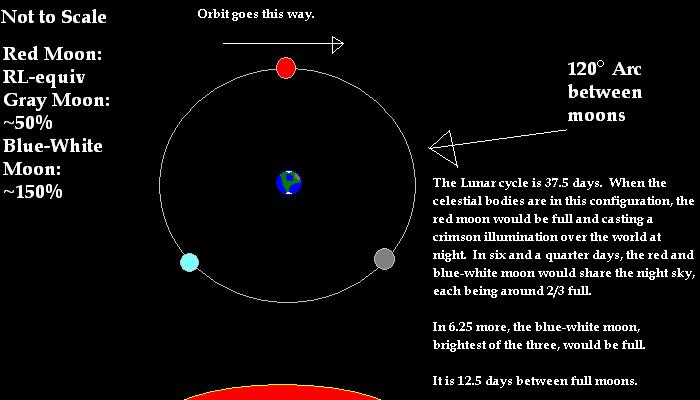Difference between revisions of "The Wyzard Setting Essays"
The Wyzard (talk | contribs) (→Known Gods) |
The Wyzard (talk | contribs) |
||
| Line 1: | Line 1: | ||
| − | Here are some setting essays for my | + | Here are some setting essays for [[my Fantasy Trip campaign.|http://wiki.rpg.net/index.php/The_Wyzard_Runs_OD%26D]] |
== Known Gods == | == Known Gods == | ||
Revision as of 09:28, 15 May 2011
Here are some setting essays for http://wiki.rpg.net/index.php/The_Wyzard_Runs_OD%26D
Contents
Known Gods
There are many, many beings of sufficient power to arguably merit worship. This can be construed as a matter of scale. A demonic imp with delusions of grandeur might eventually teach a troupe of small monkeys to bow down and give it offerings; the relation of a demon price to its human cultists is not different in kind.
Clerics may serve some particular god or another, but they need not. Their magic is a different path from the arcane, but it is equally self-sufficient for game purposes. Because of the great many deities in the world (which might range from a gigantic alligator of ancient and inhuman intelligence worshipped by a tribe of goblins, to an actual extraplanar being with plenary powers over the material world), there will never be a comprehensive list of them. If a player invokes or worships some given being, I'm inclined to assume that being exists, in some sense, if it can be fitted into the setting in any sensible way.
Still, for purposes of versimilitude, I will list a few deities and describe them, so that players can gain a sense of the setting as it exists in my head.
The Hungry Man
The world's psychopomp and most widely recognized deity of death. He appears as a huge but emaciated gnoll, with spidery limbs and a big sack over one shoulder. When a being dies, and the corpse is not properly disposed of, their soul is collected by the Hungry Man and taken away to the Empty Lands, a featureless gray wasteland of infinite size. He curses the dead with his own endless and insatiable hunger, so that they spend eternity tearing at each other's substanceless flesh in an attempt to fill the utter emptiness within. It is occasionally possible for unusually clever and determined souls to somehow find their way back to the world from the lands of the dead. However, their hunger follows them, thus resulting in the strong tendency of the undead to desire the flesh, blood, or life energy of the living.
He Who Waits Behind the Walls
A curious but deeply sinister being, or potential being. Venerated largely by corrupt scholars, He Who Waits Behind the Walls is said not to exist in this universe yet, but may be brought into it if his history is completed. That history consists of fragmentary tales of horrific events, which seem to be either fictional, or fictionalized versions of real events. There are also philosophical concepts and alternate moralities that are considered to be component's of his corpus. His cult's major activities consist of hunting down pieces of his history and ideology (they either have some method of separating random textual detritus from authentic fragment's of His History, or perhaps they are delusional) and tricking the world into accepting them. This is the process by which they believe they can help Him into the world. If the content of his corpus is indicative of anything, his cult's success in this endeavor would be a very bad thing.
That Which is Concealed Beneath the Surface
A Lizardman deity of great antiquity, this being is venerated as an icon of strength and fertility. It is usually pictured as a great crocodile or alligator submerged underwater. While worship of That Which is Concealed likely dates back to the Lizardmen's civilizations before the dawn of human history, it is still actively propitiated both by the degenerate Lizardmen of the modern era, and often by humans who live in hot, swampy, or jungle-like environments. The ritual veneration of That Which is Concealed is generally a barbaric affair, with great bonfires in the humid night, and secret, orgiastic rites.
The Rime-limned Queen
A being of vast and ineffable knowledge, the Queen came to the world from the stars, and is now said to float in the heavens amongst the Moons. Rites to her are conducted at night on high plateaus, and often involve strange lights in the sky and consorting with otherworldly beings. Her clerics often display strange scars and disfigurements. The Queen is taken quite seriously by demons and devils, as she has demonstrated the ability to interdict them from passage between their realms and the earth.
The Guardian of the Eighth Spiral
Usually depicted as a huge mass of serpents, heads and bodies extending from a sphere made up of all their tails melded together. A kind of protector-spirit which is set on places which are to be absolutely forbidden. There are very few clerics devoted solely to this deity; they tend to convert to its special service after already achieving great power through a prior path. This deity is also sometimes invoked in proceedings to deliver horrific curses on one who has committed a major transgression. For example, a host who killed his guest in violation of Hospitality might have his body permanently infested with small, flesh-devouring worms in this deity's name. No one knows precisely what the Eighth Spiral is, nor what happened to the previous seven.
The Cult of Forst the Sexton
Forst began his mission a century ago, burying the dead to deny the Hungry Man. His disciples spread his practices, and roam the world, attempting to properly set the dead to rest. Preferably by burying, but entombment or cremation if neccessary, even exposure or in extremis symbolic anthropaphagy. Anything is preferrable to a soul being condemned to the Hungry Man's hell.
They frown upon the practice of internment with grave goods. "A Rich Grave is a robbed grave" is one of Forst's maxims. "you can't take it with you" and "Life's for the Living" being two of his other proverbs.
The Wolf of the World's Ending
A being of enormous size and unlimited destructive potential. The legends describe this entity as a wolf, which is bound about with chains of red-hot iron, and trapped in the very center of the world. This description is largely poetic, although not completely inaccurate. The creature has indeed been imprisoned, by who knows what power, at the planet's core. All educated people know that the Wolf is the root of lycanthropy, as it sends dreams of beastial madness up to the people on the surface of the world. These dreams are of such power that they can not only unhinge the mind, but also contort the body into a supernormal wolf, or some other animal shape that is sufficiently rooted in the Jungian realm. The prophecies that the Wolf's eventual escape from its prison will shatter the world into splinters is, unfortunately, probably accurate. However, by monitoring the activity of volcanic eruptions (caused, of course, by the Wolf's struggles and contortions), sages estimate it will be at least ten thousand years before there's anything to worry about.
The Drinker of Spilled Blood
Despite its ominous name and grisly eating habits, the Drinker can be a fairly benign deity. It requires no more sacrifice than that blood be spilled, and is just as satisfied to have an animal's throat cut, or two dozen people giving up only a little blood. Keeping the Drinker satisfied prevents infestations of mosquitoes and other biting vermin. However, its attention is also sought out by those wishing to become vampires, as the attentions of its servitors are necessary for that process (absent some accommodating senior vampire.)
The King in Yellow
One of the rare deities with a clear alignment, the King is explicitly associated with Chaos. Along with portents of doom and disaster, which the King may in fact be the cause of, he is a source of Arcane magic and other secret lores. Destroying the difference between truth and falsehood opens the door to the King; he is called upon by certain plays and cunningly-engineered masquerades.
Astronomy
Demons, arcane magic, and many other dangerous phenomena originate among the outer darkness where the stars wheel and laugh. Across the indigo gulf of time and space, horrors and unnatural power come to visit the world of men. Beware the ice-rimed creatures who descend from the sky, for their journeys have been long and their places of origin strange beyond reckoning. Who knows what ends they may pursue, so far away from their natural place in the cosmos?
The Moons
There are three moons orbiting the world, spaced evenly around a single orbital period. Thus, at almost any time, there is at least one moon in the sky, and many nights there are two. One bears a reddish cast, the other a bluish one, and the last is a dark slate gray. They are considered to be the primary sources of magical power in the world, and also rich with demonic and other entities who may be summoned by some means or another. It is thought that there are likely entire civilizations dotted about their surface, perhaps of incredible antiquity.
History
The following are in roughly chronological order, although poor record-keeping and the encroachments of Chaos have left history in a slightly confused state.
The Lizardmen
Deep in the mists of history, the Lizardmen had a mighty civilization. Little is known of them, as even for those who are proficient with their language find the meaning of their pictograms inscrutable. The Lizardman brain is formed differently from the human one, and communication between the species is often difficult. It is known that they were highly accomplished in certain forms of architecture, as many of their pyramids and ziggurats still stand. They also had some unusual form of magic, or highly-developed psionic power, which relied on great crystalline structures. However, the modern Lizardman is a debased and ignorant creature, uncomprehending of his people's own written language or their history. What might have wrought this change in them is completely unknown.
The Amaranthan Empire

One of the more historically "recent" Great Civilizations, the Amaranthan's were unparalleled masters of sorcery. Their ways were debased and vile, but they crushed kingdoms as a dragon might smite a bugbear. A heavily chaotic race, the Amaranthans eventually rebelled against those beings claiming the status of deityhood. It galled them that any being should arrogate to themselves a higher station than what their Emperor appointed. Thus began the dreadful God-War of the Amaranthan Empire. It raged on for centuries, and the Amaranthans did in fact manage to subjugate the four major elements - to this day the great elementals are unusually susceptible to the antique sorceries to which the Amaranthans bound them. The war did not end, however, and each new year brought more powerful beings into conflict with the unbelievable might of the Amaranthans. The great houses were eventually tempted to rebel against the endless war, and the Empire self-destructed in a decade of blood and fire. The ruins and deep fastnesses of the Amaranthans are still considered to be some of the most valuable and dangerous sites for adventuring; they had vast wealth and had created innumerable artifacts.
It is said that there is somewhere a desert wasteland, at the center of which is a huge black obelisk engraved with the names of all those deities slain during the God-War.
The Thracian Hegemony
The Thracians began as a small group of seafaring nations, which eventually conglomerated and combined their efforts. They rapidly became masters of the exchange of goods, and proceeded to dominate, incorporate, and subvert every economic entity they could come into contact with. Their complex arrangements of ownership and finance allowed them to trick simpler peoples out of their wealth with impunity. They also reached incredible heights of technical prowess, and mastered the physical realm in a way that had not been seen in millenia. Their hubris was boundless, and it was inevitable that they would begin to have truck with the beings inhabiting the moons, the dark between the stars, and the lands in the hollow world. They had crafted bargains with powers that ought not have been bargained with, and the Hegemony was decapitated in a single blood-soaked night when the account came to be paid. Bereft of leadership, barbarians and lesser kingdoms raided and destroyed the remaining centers of Thracian power. Their society disintegrated, and the lore of operating their great machines and mysterious facilities became lost.
Almanac
Coinage and Precious Metals
The valuable coins of the current era are drastically, although uniformly, debased. It was found by the ancient Thracians that there was insufficient in the way of genuine gold and silver to fuel their mighty trading empire. So, they debased the coinage in order to accomplish two ends: One was to make the wealth of their nation more finely divisible than the large gold disks which were popular at the time, and the other was to defeat the worst of the coin shaving and similar undertakings.
So, they standardized their coinage into three major types, all of the same size: The copper coin, least valuable and pretty much all copper. The Silver coin, of middle value and containing a substantial portion of silver, although other white metals went into its construction and made it more resistant to wear. The Gold coin contained very little actual gold indeed, although it still had a pretty yellow color to it. The new alloy was in fact many times stronger than pure gold, and so defeated those who would jingle their coins in a rough leather bag to gather gold-dust.
All the coins were made with a ridged edge to defeat shaving, and were relatively simple flat slugs with some text or a simple symbol on them. To defeat counterfeits, their alloys were precisely calculated and the formula kept secret, so that their density was precisely determinable. In this fashion, a merchant with one of the standardized weights and a scale, a marked glass tube, and a bit of clear water could determine the genuine-ness of any coin with relative ease.
While the Thracian Hegemony is no more, the trade network they established was so widespread that their coinage became the standard in every civilized land in the world. To this day, no kingdom with economic aspirations deviates from their formulae, and wealthy merchants take pride in having original Thracian weights with which to examine suspect monies. The weights are crafted from adamantine, and so are practically beyond adulteration themselves. In essence, coinage is treated as a kind of commodity. It is created and dealt with by money-changers and similar persons of precise skills and grasping nature. Nations and nobility rarely dabble in the minting business - the normal extent of that activity is to order all coins be stamped with some patriotic phrase, or a simple image commemorating some event. Actually changing the value of coins is seen as too disruptive to the easy flow of commerce.
There are denominations of coin which are made of more valuable materials, or which are less-adulterated due to being minted in days ancient beyond reckoning. These will be treated as special treasure. The adulteration of the coinage is why a simple gold ring might be worth ten or even a hundred gold pieces, even though it has an encumbrance value equal to only a single one.
The Calendar
Each month consists of four weeks, each one of eight days. The Eighth day of each week is, by tradition, some type of feast or holiday. While the identity of that feast or holiday can vary wildly from city to city and nation to nation, it is nonetheless usually taken as a day of rest from labor. A master who gives his slaves any great amount of work on the eighth-day is usually seen as a skinflint. Each year consists of thirteen months, for a total of 416 days in a year. The moon's orbital period used to precisely coincide with the months, but it was disrupted during the same disaster that caused the world to begin wobbling on its axis, thus creating the seasons. They are now more distant, having an orbital period of five weeks. The Lunar calendar is therefore of very little use.
In cultures that keep track of Birthdays in any sense, it is most normal for a birthday to be recorded as the feast-day ending the week of that birth. The other days of the week are undifferentiated in the mind of the populace, and are often not even named in anything other than an ordinal way.
Geography
The Hollow World
Scholars, of course, know that there is no hollow world, and that the entire business results from drastic misapprehension and ignorance.
It is indeed possible for those who are willing to brave the dangers of extended travel through vast, uncharted caverns in the world (and the unspeakable creatures, forgotten by the light of day, which inhabit them) to come to a strange and entirely different planetary surface, which sits under a different sun and different stars. The people of that sphere, of course, insist that their own sphere is the true one, and that the world of the traveler is in fact the hollow world of their own planet. Both the native and the traveler have committed the fallacy of dimension-centrism. In fact, it is the same planet, but with two different surfaces areas in alternate areas of spacetime. The tunnels are those places where the (contiguous) surfaces wrap in and around four-dimensional space
It will be most helpful to picture the arrangement as a Moebius Strip, or more accurately as something like an arrangement of interlocking Klein Bottles. Or, perhaps, that won't be helpful at all.

